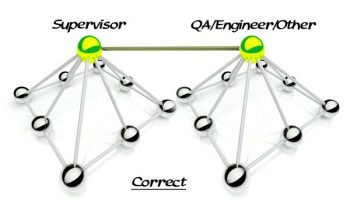Pyramids and jumping chain of command
In the army they taught us that jumping the chain of command is against military law. Breaking this law would lead to being prosecuted for undermining authority, and to rather unpleasant results. For the perpetrator.
Today we are no longer in the army, and no-one will prosecute us for jumping the chain of command. However, I would like to bring to the discussion table a totally different view of said chain of command and the correct and incorrect way to use it.
With that purpose in mind, let’s first take a look at the communication structure of an organization from a general wide viewpoint of proper administration. It starts with the organizational structure.


Pyramid
Every organization built according to the lines of proper administration has a pyramid structure. At the top there is a single CEO/General Manager/Director/owner or however he is called. The next level is occupied by the top/senior management, then comes the wider mid-management, and then, at last, at the wide bottom level of the pyramid – the “simple workers”.
To allow for normal work flow, all levels must communicate with each other in a well-defined formal manner.
From top to bottom and the other way around formal vertical communication takes place, including information, instructions, requirements, reports, feedback etc. This is communication between a manager or supervisor and the people he is directly responsible for. It is also communication between these people and their direct managers. It goes both ways.
From right to left and the other way around formal horizontal communication takes place, including information, verification, details needed to complete the picture, feedback, etc. This is communication between “equals”, between colleagues at the same level of organizational hierarchy. Its purpose is coordinating between different elements. It does not exactly go two-ways, more accurate would be to say many ways.
Instructing incorrectly
Now let’s examine for example a communication, taking place in most places several times a day: what happens when a QA person, an engineer, a logistics employee or any other has instructions he needs to communicate to workers, or production line operators. For simplicity, let’s call that person a third party, as he is not from the operators’ production department.
The third party arrives at the production floor with his extremely important instructions, approaches the workers and issues his instructions. Naturally, these are NOT the instructions they have received previously from their supervisor, or they would already be implementing them, right?
The third party considers this to be a very important communication task and, surely, his natural right, by residing on a higher step of the organizational hierarchy. Unfortunately, at that moment, due to a general lack of understanding of organizational communication and its implications, he has just created several severe difficulties, the consequences of which would be felt for a long time further down the line:

Who is the boss?
The workers have been just placed before a choice: whether to continue working according to instructions issued by their supervisor, or accept the third party’s new instructions.
They clearly understand that if they implement the new instructions, and their supervisor asks why they did that against his own instructions, it would either jeopardize their job or erode the work conditions. Thus, almost every time the workers will choose their supervisor above any other party. It is he who pays their wages.
Someone other than their supervisor came to issue instructions. Does that mean his authority is higher than their supervisor’s? Has he more power in the organization?
Both the sense of authority the third party brings with his station and the very existence of these questions harm the future authority of the supervisor. This will directly and severely damage any future cooperation between the supervisor and said third party and creates obstacles to their working relationship. This is directly damaging the plant.
In addition, it shakes the workers’ confidence in their ability to make correct decisions. This places them in an internal conflict, from which they would emerge hurting either their supervisor or the third party. Meaning that for a higher level authority they will be wrong in any case. They witness a power struggle and a future blow to any cooperation efforts.
What about the third party’s authority?
If the new instructions happen to be given in an imperfect way, or need to be corrected, changed or cancelled, the third party’s authority will be damaged. Now the workers will not trust what he has to say, as they did before.
And if the workers were reprimanded for accepting the third party’s instructions, again his authority will be damaged. Now every instruction he issues will be received with suspicion and resistance, because of that reprimand. The workers justifiably feel he should have gone through proper channels, and they are carrying the responsibility for someone else’s actions.
Incomplete instructions
Such instructions create a “word-of-mouth” culture in your organization, something you would want to avoid at all costs.
So you instructed a worker or two. What about the next shift? And the one after it? What about changing instructions in the system?
We are all well familiar with situations where we are certain the workers perform operations in a certain manner only to arrive one day on the work floor during that very operation and discover it is otherwise. We ask: “Why are you doing it this way, instead of what is written in the assembly instructions?”, and receive the answer which drives us up the wall: “Oooh, we’ve been doing it this way for ages! X number of years ago Y has instructed us to do it this way!” This can simply drive one nuts, and there is nobody left who even remembers this Y person who left the company long ago, nor does anyone know why the instruction was given in the first place. And the most maddening of all: why has it not been recorded in the assembly instructions?
There, that is precisely where this starts.

Ladies and gentlemen, do not put your workers in such situations. Don’t make them carry the outcome of other people’s mistakes more than they already do by constantly repairing non-conformance originating in lacking design or improper purchasing of raw materials.
Why would you want to create such conflict situations in your organization? In this scenario everyone loses, without exception.
So what can we do? Be patient, coordinate our actions with others out of respect and empowerment.
What does that mean? Simply using both vertical and horizontal formal communication channels correctly.
Instructing correctly
The person from QA, engineering, logistics or any third party outside of the production department are NOT the direct managers of the operators, and are therefore not authorized to issue instructions to them.
Instead they need to act according to the general order of proper administration. The third party should communicate the instructions to the supervisor, whether at a team meeting for the whole project team or at a private meeting in the supervisor’s office. Coordination between them must be carried out on the formal horizontal communication level.
Then, according to their agreement, they should both go out to the operators at the work floor, and the third party would simply be present, lending additional support to the instructions, which would be issued by the supervisor.
“Urg, bureaucracy…” I can hear from some of you. And when we say “bureaucracy” we mean performing unnecessary actions intended solely for reporting and recording, without any practical use and generally wasting time.
Allow me to demonstrate why this is the exact opposite of bureaucracy, and what are the direct benefits to all from such a situation.
No inner conflict for the worker
The worker receives his instructions from his direct manager. He is free from inner conflict about whom he shall listen to and whether to implement… His manager instructed him, and this is a clear, natural and familiar situation, as it should be. Now the chances of correct implementation are much higher.
The worker’s confidence in doing the correct thing is also unshaken. In addition, he is sure of his standing, for the instructions are clear and there is no doubt of his ability to meet them.
Coordination demonstrates accord
The third party shows support for the supervisor, empowers and increases his authority by just being present. This support and presence also have the effect of empowering the workers regarding the new instructions: there is wide agreement about them, the different elements are in accord. This is not a situation where the right knows not what the left does.
Third party empowerment
The accord between the third party and the supervisor also builds trust in the third party: after all, the supervisor stand united with him, there is no strife. This empowers and builds up the third party’s authority.
The system is up to date
The coordination across the organization results in the whole system being up to date with every change in its instructions. It is a simple matter to extend the coordination to the whole project team, and to update the written assembly instructions at the same time or, perhaps, after the change is proven to bring the desired results.
It frees the organization from “word-of-mouth” culture, allowing order and clarity everywhere.
All the above are direct benefits to the organization, the results of which are to be experienced in less conflicts and lower resistance, higher morale, better work quality, improved trust, timely reporting… in short – profits!
Everybody benefits from this scenario, without exception.
So now you tell me, is it not worth a little patience, using the built-in system tools and receiving so many benefits, instead of insisting on doing it yourselves the old way – and reap all the troubles and losses I demonstrated above?
The choice is yours.
It is true, nobody will prosecute you for jumping the chain of command, but you would just as surely set your own sentence.
Or, alternatively, you may agree to see the larger picture, an incredibly simple tool easy to implement and bringing empowerment and benefits to all, including yourselves…
The picture with the musician and conductors: original image taken from the LDS website of the Mormon church.
This post is available also in:
 עברית
עברית
You may also find interesting:
Powered by Contextual Related Posts













